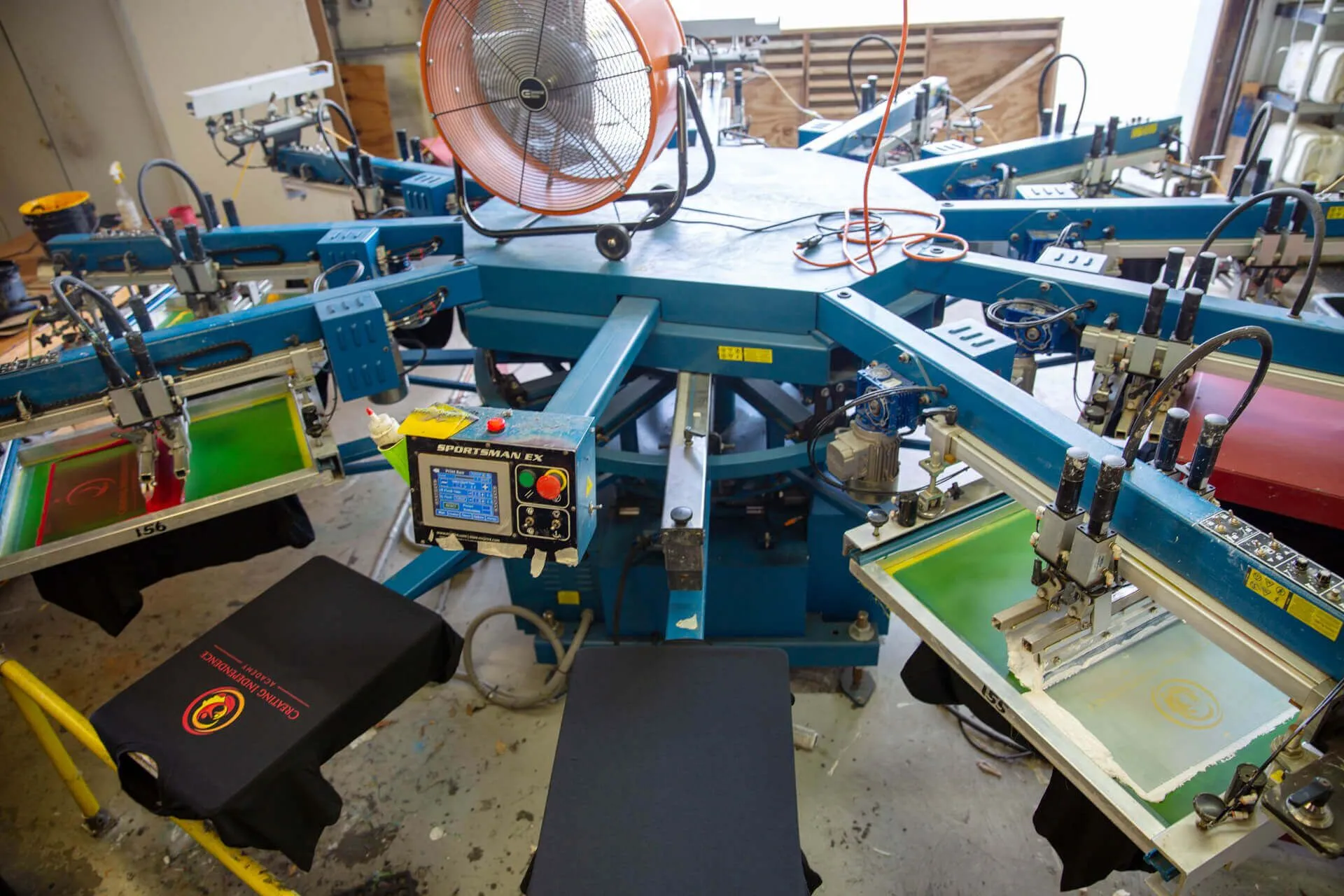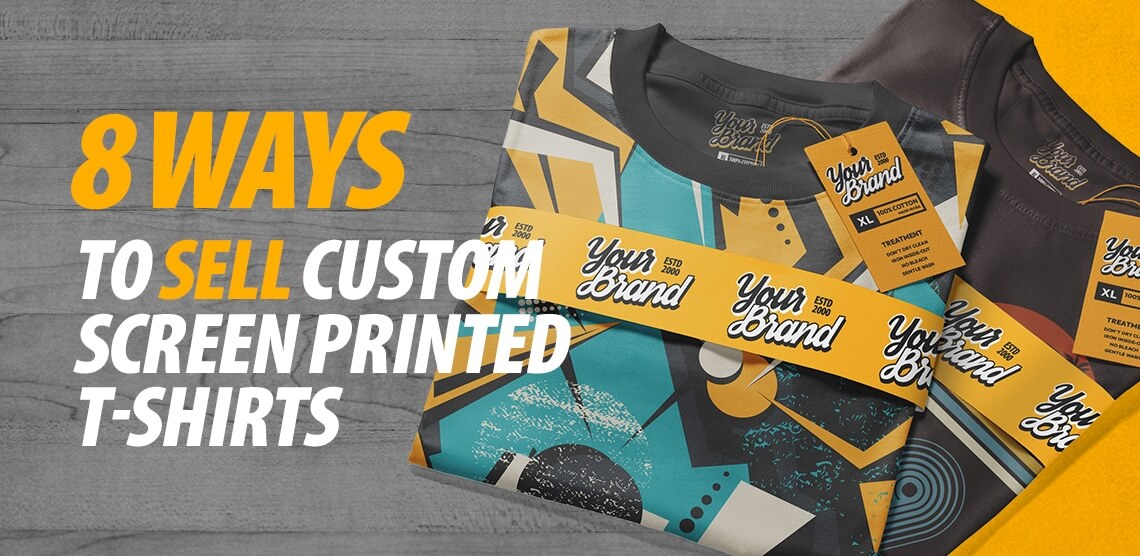The Ultimate Display Printing Package: Essential Devices for Effective Garment Printing
When it comes to screen printing, having the right tools can make all the difference. What about the inks and screens? You'll quickly uncover just how these parts function with each other to boost your printing video game.
Comprehending Display Printing Basics
When you involve on your own in screen printing, you'll discover it's both a science and an art. Once dried out, you subject the screen to UV light with your layout put on top, enabling you to create a stencil.
Next, you'll establish up your printing station, straightening your display with the garment. Using a squeegee, you'll press the ink with the display, making sure even coverage. The appeal of display printing hinges on its adaptability; whether you're publishing strong graphics or intricate patterns, the process remains the very same.
As you method, you'll discover ink kinds, drying times, and shade mixing. Each print is an opportunity to refine your strategy and express your creative thinking, making screen publishing a satisfying undertaking for any person enthusiastic about layout.
Important Elements of the Screen Printing Set
To begin with display printing, you require to understand the crucial components of your set. You'll wish to familiarize yourself with the standard equipment, the types of inks and solutions you'll use, and the tools for application. Each component plays an important function in attaining high-quality prints on your garments.
Fundamental Tools Overview
A fully equipped display printing package is important for any individual aiming to create sensational garment styles. Beginning with a sturdy screen printing frame, which holds your mesh firmly for exact printing. You'll likewise require a squeegee to press ink via the mesh onto your textile. Do not forget the direct exposure unit or source of light, vital for moving your style onto the display. A washout terminal assists you tidy screens after usage, guaranteeing they're ready for your following task. Spend in a registration system to align multiple shades properly. With these essential parts, you'll have a strong structure for your screen printing journey and can concentrate on bringing your imaginative visions to life.
Inks and Solutions
After gathering the standard devices, your next emphasis ought to get on inks and solutions, which play an essential function in achieving resilient and dynamic prints. When picking inks, think about water-based, plastisol, or discharge inks based upon the material kind and preferred coating. Water-based inks are soft and environment-friendly on garments, while plastisol offers durability and brilliant shades.
Emulsions, on the various other hand, are important for producing your screens. They help create the pattern needed for printing - custom screen printing. You'll desire to choose a top quality solution that matches your ink type and direct exposure method. Bear in mind to store inks and emulsions correctly to keep their performance. With the ideal selections, you'll set the foundation for magnificent, professional-grade prints.
Devices for Application

Selecting the Right Screens for Your Projects
When you're choosing screens for your projects, the mesh count and framework product are necessary variables to consider. A higher mesh matter is wonderful for great information, while the right framework product can boost resilience and stability. Understanding these elements will certainly assist you achieve the very best lead to your display printing ventures.
Screen Mesh Matter
Picking the appropriate display mesh count is necessary to attaining the preferred outcomes in your screen printing jobs. The mesh matter refers to the number of strings per inch in the display, impacting how much ink obtains transferred onto your garment. Always take into consideration the type of ink and fabric you're utilizing, as these variables influence the mesh count selection.
Mount Material Options
The screen framework product you pick plays a significant function in the high quality of your prints. You have actually obtained a few options to assess, each with its advantages. Aluminum frameworks are light-weight, sturdy, and immune to corrosion, making them excellent for lasting usage. They provide outstanding tension, making certain crisp prints. On the various other hand, timber structures are much more standard and can be extra affordable, but they're heavier and might warp with time. You may choose aluminum for its integrity if you're simply beginning. For larger tasks, pick structures that can hold up against the stress needed for fine details. Inevitably, choose a material that suits your workflow and spending plan while guaranteeing your prints come out looking sharp and professional.
Picking Inks for Different Fabrics
How do you ensure your screen printing layouts look dynamic and last on different fabrics? Choosing the best ink is vital. For cotton, water-based inks are your best choice. They saturate right into the material, providing a soft feeling and excellent durability. Think about making use of plastisol inks if you're printing on polyester or synthetic blends. They rest on top of the fabric, guaranteeing intense colors and great attachment.
Do not neglect about specialty inks like discharge or metallic inks. Discharge inks can eliminate color from textile, leaving a soft print, while metal inks add a shiny finish that stands out. Constantly examine your inks on the specific fabric before dedicating to a big run; this assists you assess shade vibrancy and sturdiness.
Last but not least, remember the textile's weight and appearance. Choosing the right ink for each fabric type will certainly assure that your designs not just look fantastic but also endure the test of time.
The Importance of Squeegees in Printing
Mops play an integral role in achieving high-quality prints in display printing. They're your key device for transferring ink through the stencil onto the textile, and the ideal squeegee can make all the difference. When you apply consistent stress with a squeegee, you ensure an even distribution of ink, lowering the opportunities of blotchy or unequal prints.
Picking the best durometer or solidity of your squeegee is important, as it influences just how much ink is drawn via the mesh. A softer squeegee is excellent for comprehensive layouts, while a firmer one works well for strong graphics. In addition, the width of the squeegee must match your display dimension to optimize your printing process.
Taking some time to understand your strategy with the squeegee will result in cleaner, sharper prints. So, do not underestimate this important device-- be familiar with it, and you'll raise your screen printing video game.
Preparing Your Art Work and Solution
Achieving terrific prints starts long before you select up your squeegee. When you're satisfied with the layout, print it on openness movie, keeping in mind that the darker the image, the better it obstructs light throughout direct exposure.
Following, choose the ideal emulsion for your project. Apply it equally to your display in a dimly lit area to prevent premature direct exposure. Enable it to dry completely, preferably in a dark area, to ensure outstanding results. Once your display is prepared, expose it to UV light according to your solution's guidelines. The light will certainly solidify the solution where it strikes, leaving your style unexposed.
After rinsing the unexposed emulsion, allow the screen completely dry completely. With your art work and emulsion prepared, you're established for the printing process!
Upkeep Tips for Resilient Tools
Although it might seem laborious, regular maintenance of your display printing tools can considerably extend their life expectancy and warranty consistent results. Begin by cleansing your screens right away after use.
For squeegees, clean the blade after each use to avoid ink from drying out on it. Routinely inspect for nicks or damages and change them as needed. Don't forget your direct exposure unit-- clean the glass surface consistently to confirm perfect light exposure.

Often Asked Questions
Can I Screen Publish on Dark Colored Fabrics?
Yes, you can screen print on dark colored materials! Simply make use of a suitable opaque ink created for dark products.
Just how Do I Tidy My Screens After Printing?
To clean your screens after printing, you'll require a stress washing machine or hose to remove excess ink. Then, use a screen cleaner or moderate detergent with a soft brush to scrub away residue. Wash completely.
What Safety Gear Do I Need While Screen Printing?
When display printing, you'll require handwear covers to screen printing kit protect your hands, a mask to prevent breathing in fumes, and safety and security goggles to secure your eyes from chemicals and inks. Being cautious assurances a risk-free and delightful experience.
Can I Make Use Of the Set for Other Materials Besides Fabric?
Yes, you can use the package for various other materials besides fabric. It works well on surface areas like timber, paper, and plastic. Just make certain the ink and strategies fit the material you choose.
How Lengthy Does It Consider Ink to Cure?
Ink generally takes about 24-hour to treat fully, yet it can vary based on the kind and thickness. You'll intend to examine the maker's guidelines for specific healing times to ensure optimal results.
Utilizing a squeegee, you'll push the ink via the screen, ensuring also coverage. You'll require a trusted squeegee, which assists evenly distribute ink across your screen.Picking the ideal display mesh count is essential to accomplishing the desired outcomes in your screen printing jobs. The mesh count refers to the number of threads per inch in the display, affecting just how much ink gets transferred onto your garment.To cleanse your screens after printing, you'll need a pressure washing machine or hose to get rid of excess ink.